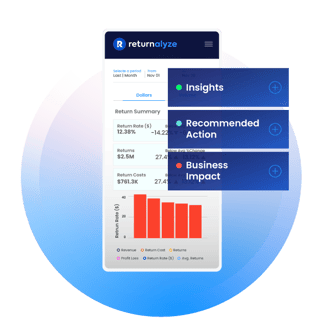Want expert guidance on your return policy? Read key takeaways from our recent webinar with Dr. Wesley Boyce
The days of creating a return policy that you can “set and forget” are long gone. These policies can impact every level of business, from customer acquisition and brand reputation to net revenue. Plus, changing consumer behaviors and industry upheavals can make previously successful return policies woefully outdated.
That’s why many retailers are now asking new questions, such as whether or not free returns should only be available for loyal customers, how a return policy differentiates you favorably from competitors, or even whether return policies can deter returns abuse.
That’s why conversations like the one we had with BWG Connect are so important. Returnalyze Chief Analytics Officer John Bowman and our VP of Customer Success Christine Bradford joined Assistant Professor Wesley Boyce of the University of Nebraska-Lincoln to discuss the multifaceted nature of return policies and the many factors that should be considered when revising them.
If you missed the live event, don’t worry. Today, we’re covering the key takeaways from this conversation so you can benefit from their expert guidance.
When Should A Business Change Its Return Policy?
Considering the impact return policies can have on net revenue, it’s vital to determine when changes are appropriate. Depending on a variety of factors, from industry changes to shifting consumer behaviors, both waiting too long and acting too quickly can be problematic.
Businesses that wait until customers are frustrated with a return policy put their reputation at risk, they could lose shoppers to competitors, and they may incur additional costs if the price of return transactions increases. Making changes too soon, or even making unnecessary changes, can be confusing for both shoppers and sales associates, which can also lead to poor customer experiences.
Any time is a good time to evaluate whether your return policy makes sense.
John Bowman
Chief Analytics Officer
Returnalyze
That’s why continuous evaluation is the only way to determine when it’s time to make changes to a return policy. That means regularly assessing returns analytics, customer feedback, and industry trends. This data can provide specific KPIs to measure the effectiveness of a return policy:
- Return rates
- Length of time for customer returns
- Post-return customer behavior
- Profitability
- Cost per return
- Return reasons
This information will not only help businesses determine when it’s appropriate to make changes but also provide insights into the type of changes that may need to be implemented and whether or not those changes are having the desired effect.
Wesley Boyce, assistant professor at the University of Nebraska Lincoln, put it best when he said, “Use your data. Look for that objective evidence that what you’ve done is working. It’s going to tell you the truth.”
Create More Effective Return Policies with Data-Informed Changes
Making return policy changes without relying on data is like throwing darts at a bullseye… in the dark. No one return policy is going to be perfect for every business. Some retailers may even need a dynamic return policy that allows for flexibility in certain scenarios. That’s why data-informed changes are vital.
By analyzing return rates, customer behaviors, and even product-specific data, businesses can implement targeted changes to address specific areas of concern.
For example, insights from customer feedback can be incredibly valuable, and the right returns management platform can easily analyze this unstructured review data. By cross-referencing returns analytics with review data, businesses can pinpoint specific return policy issues and develop an action plan to resolve them.
Running a small pilot program to test policy changes can also be beneficial. This gives businesses an opportunity to gauge customer responses and minimize potential risks before fully implementing return policy changes.
Policy Changes Need Planning and Communication Time
In addition to continuous evaluation, revising a return policy involves building enough time to inform internal and external communication channels about any potential changes.
Before a new return policy ever reaches consumers, several internal departments should be well-briefed. Marketing departments may need to develop materials that help communicate these changes. If the new policy impacts return logistics, then the supply chain must be notified so they can be prepared. Customer service, in particular, must be aware of every last detail of the return policy in order to help shoppers during the transition.
Thoroughly communicating these changes to all relevant internal departments is important to ensure a cohesive transition from the old policy to the new one. Adequately communicating these changes to customers is equally important.
Clearly communicating policy changes to customers helps manage their expectations while maintaining trust. This may involve updating the website and marketing materials, email newsletters, social media posts, and even additional reminders during the checkout process.
Flexibility and Adaptability in Return Policies
As we’ve mentioned previously, no one policy will fit the needs of every business. Furthermore, a blanket policy for every transaction may not be appropriate either. That’s why a dynamic return policy with flexibility may be beneficial.
For example, retailers with international customers may need a policy that takes into consideration factors such as increased shipping costs, shipping times, and even regional differences in consumer behavior.
It may even be appropriate to make certain product categories ineligible for returns. Price point, weight, and even the potential for damage should be taken into account when deciding whether a product category should be eligible for returns.
Additionally, businesses that can quickly adapt their return practices to changing circumstances are more likely to thrive in their respective industries. For example, the cost of processing returns has increased greatly over the past few years and may very well increase again. If the cost of returns becomes too great, businesses may decide to allow customers to keep items instead of processing the return.
Bottom line? Businesses should remain flexible and open to updating return policies as new scenarios present themselves and as new data becomes available.

Partner with Returnalyze for Expert Guidance on Returns
Return policies can be complex, whether you’re creating an entirely new policy or revising one that’s been in place for years. While adding fees may be necessary, consumers won’t like them. Free returns may attract new customers, but they can also increase returns abuse. It’s all about finding the right policy for your business. At Returnalyze, we can help you do just that.
Not only does the Returnalyze Intelligent Dashboard give you access to the KPIs you’ll need, but a partnership with Returnalyze comes with step-by-step guidance and analysis from our data experts.
Don’t get overwhelmed by data. Let the experts help you find return policy solutions that keep your customers happy and grow your net revenue.
Schedule a demo or contact our team today.

